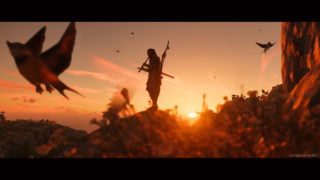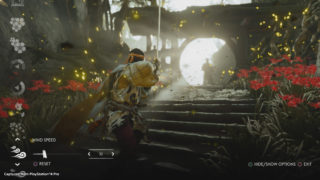Review: Ghost of Tsushima has atmosphere and sharp combat, but too much filler
Sucker Punch’s Kurosawa homage forges its own identity, but is weighed down by the genre’s more perfunctory tropes
- Game director
- Nate Fox
- Key Credits
- Jason Connell (Art director), Shigeru Umebayashi (Composer)

Riding through the lush fields of Tsushima Island, we draw near a fox den. Its occupant emerges then hops away, yelping for us to follow, and leads us to a small stone shrine tucked into a rocky alcove. We dismount to offer a prayer and pet the fox. It’s a welcome moment of serene respite from our bloody war against an invading Mongol horde.
Hours later, as we approach Ghost of Tsushima’s finale, we’ve replicated this ritual 16 times in 16 different locations – see fox, follow, pray, pet. The sense of spiritual replenishment has long since waned, and we continue to indulge our vulpine friends purely for the reward of extra charm slots on our sword. Completionists will need to find 49 of these Inari shrines. Sucker Punch’s samurai adventure has a habit of dampening its magic with excessive repetition.
More Ghost of Tsushima
Ghost of Tsushima: Director's Cut PS5 review | Ghost of Tsushima PS4 save transfers | The real Ghost of Tsushima island
Each new experience in the game’s open world is accompanied by notification that we’ll encounter carbon copies throughout the journey. Menus include a ‘collections’ page, in which sites such as hot springs, mountain shrines, lighthouses and haiku spots, as well as objects from military banners to scrolls and caged crickets are arranged in neat boxes, ready to be catalogued and counted.
Most of these activities do serve a practical purpose, bolstering supplies of tradeable goods, feeding into upgrade trees or increasing wardrobe options. But many of them aren’t really interesting things to do so much as things to look out for, deposited into the countryside at regular intervals for want of the creative discovery in a game like Breath of the Wild.
This overkill of stuff feels doubly incongruous in a setting that exudes the pensive ambiance of classic samurai films. Ghost isn’t always the most technically advanced title in terms of sheer visual detail, but there’s careful artistry in its vision of feudal Japan, most striking in its use of colour, dynamic weather and haunting soundtrack. As the sun sets behind a golden forest carpeted in crimson flowers, or fireflies dance above the swaying pampas grass to a wistful flute melody, quest markers and shopping list objectives feel like crass digital noise.
Narratively, too, attractive foundations are compromised by some robotic design. Ghost cleverly weaves its lore around folklore and whispered reputations, as lone samurai Jin Sakai seeks to form a gang of misfit warriors to strike back against the occupying Mongols. The tales of these individuals play out alongside incidental encounters with oppressed villagers or legends of powerful relics recounted by travelling musicians, while Jin’s own legacy is shaped as he abandons his samurai code to become the island’s terrifying saviour.
Yet the content of side quests quickly falls into predictable patterns. Bouts of directed travel, suspect trailing or footprint tracking invariably wrap up with minor skirmishes or settlement infiltrations. They’re not so much a fresh alternative to the grand plans and battles of main missions as malnourished imitations. It’s certainly all quite painless, as navigating these tasks is unfussy and intuitive. But that’s in part because Sucker Punch often chooses easy familiarity over surprise.
“Sucker Punch’s samurai adventure has a habit of dampening its magic with excessive repetition. Each new experience in the game’s open world is accompanied by notification that we’ll encounter carbon copies throughout the journey.”
Other open world games have overcome similar shortcomings through the rich texture of their lore and locations. In Ghost, for all its tonal subtlety, the glimpses of everyday life and social frictions never truly accumulate into a substantial sense of place. The central relationship between Jin and his honour-obsessed uncle is compelling, but dialogue is often overly plain, and side characters reduced to singular motivations. There’s little here of The Witcher 3’s contrasts of tragedy and humour, or skilful intertwining of stories.
Plus, for all its beauty, the environment in Ghost is absent a sense of mystery. There are few major landmarks, while villages and outposts are furnished with copy-pasted structures. And although there’s distinct scenery for each of the island’s three regions, it is just that – scenery. Some rudimentary climbing aside, there’s no need to consider your terrain, nor will you stumble upon hidden cavernous interiors to mine for treasures. Exploration misses the diversity of Horizon: Zero Dawn’s world or the architectural wonders of recent Assassin’s Creed games.
With all this, once we’d emerged victorious from the climactic battle that rounds off the first region, it was hard to muster enthusiasm as the map for the second filled with new quest markers. And yet there is a force that drives the game forward into its later stages – Ghost jolts to life whenever Jin unsheathes his katana and enters combat against the Mongol horde.

In tune with Jin’s controlled samurai training, every fight in Ghost is a dance of measured ferocity, demanding bravery but punishing recklessness. Last-second parries are rewarded with instant kill ripostes, retaining perfect poise before sweeping fluidly into the next precise slash or stance shift. Vanquished foes are left standing, momentarily unaware of their own demise, before slumping in your wake.
With determination, a few key ability upgrades, and some dishonourable backup tools like kunai and smoke bombs, it’s possible to carve through whole squads unscathed. If you’re feeling confident, you’ll call out your enemy upon approaching their settlement, executing their champion with a single swing before methodically isolating and despatching the rest. Later in the game, as your reputation precedes you, a string of lethal strikes can send waves of panic through enemy ranks, adding to an already exquisite sense of performance feedback.
“In tune with Jin’s controlled samurai training, every fight in Ghost is a dance of measured ferocity, demanding bravery but punishing recklessness.”
There are frustrations, as the lack of lock-on and automatic camera rotation can make it difficult to target specific opponents, or keep them in view. And repetition is still an issue, with a fairly small range of enemy types and a lot of flat, open battlegrounds. Even the wonderfully tense, tightly framed duels – the closest thing to boss fights in Ghost – are a little too samey. Yet the thrill of breaking a skilled opponent’s guard, or leaping off your horse into a crowd of stunned warriors never truly pales.
Much of the time, you’ll be mixing up this direct confrontation with stealth, and apart from a few forced instant-fail sequences, it’s a fairly pleasing alternative. It competes with the draw of combat by sacrificing realism for simplicity and speed. In short, there’s always plenty of cover, your assassin’s toolset is easy to use, and the Mongol soldiers are as dumb as rocks.
Especially later in the game, your ability to confuse and butcher these hapless fools, with their one-dimensional patrol routes, short attention spans and muted sensory range, is perhaps more comical than intended. Yet, despite lacking the sophistication of Metal Gear Solid V’s sandboxes, it works to encourage mischief and enable swift transitions between covert and overt death-dealing.
Ultimately, the comparisons with other games in this review combine to tell their own story. The open world action genre has moved on dramatically since Sucker Punch released Infamous: Second Son in 2014, with the bar for environmental design, narrative delivery, meaningful exploration and emergent encounters now significantly raised.
While the studio has clearly studied this recent history, and incorporates many of its lessons, Ghost remains weighed down by the genre’s more perfunctory tropes. The combat almost lifts the whole experience, and the luscious expanses of wilderness are frequently wondrous. But the game needs something more engaging to frame that action and fill that space. No quantity of foxes can compensate for that.
Ghost of Tsushima bravely steps into a genre that contains some of the generation’s most cutting-edge experiences. While it forges its own identity and doesn’t make any major mistakes, it’s not bold enough to escape their shadows.
- Thrilling swordplay
- Beautiful setting and atmosphere
- Uninspired mission design
- Repetitive side content


























